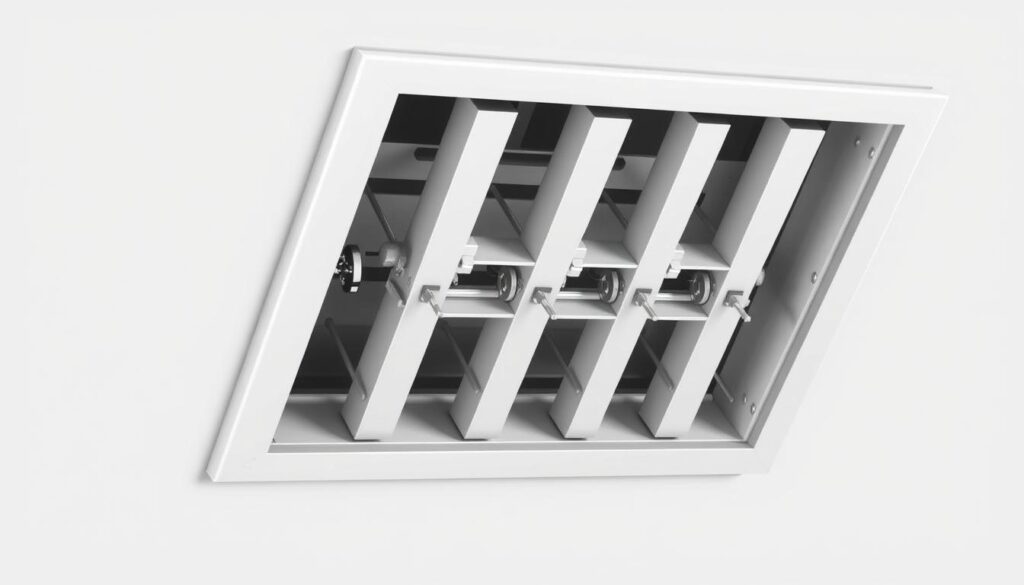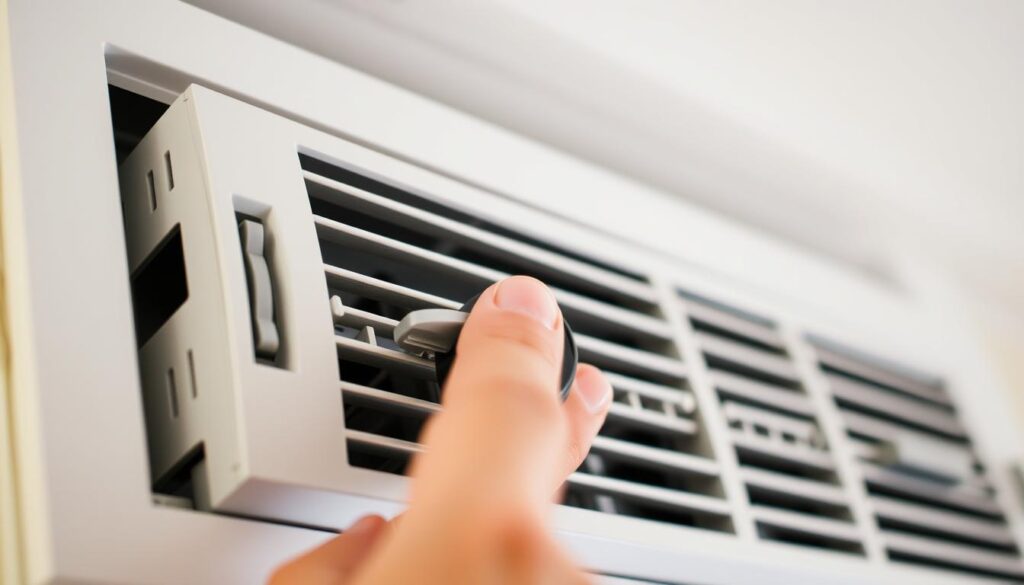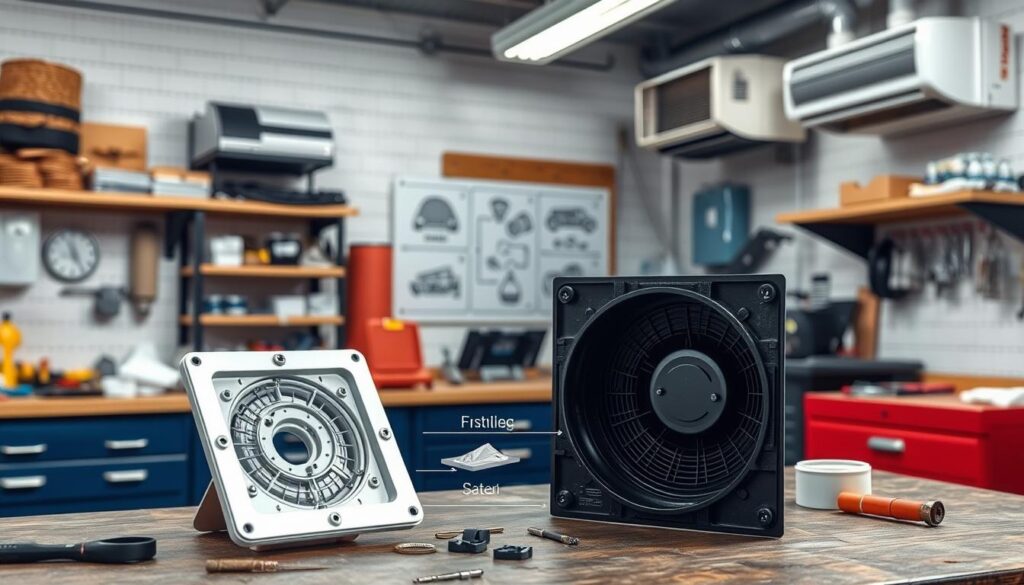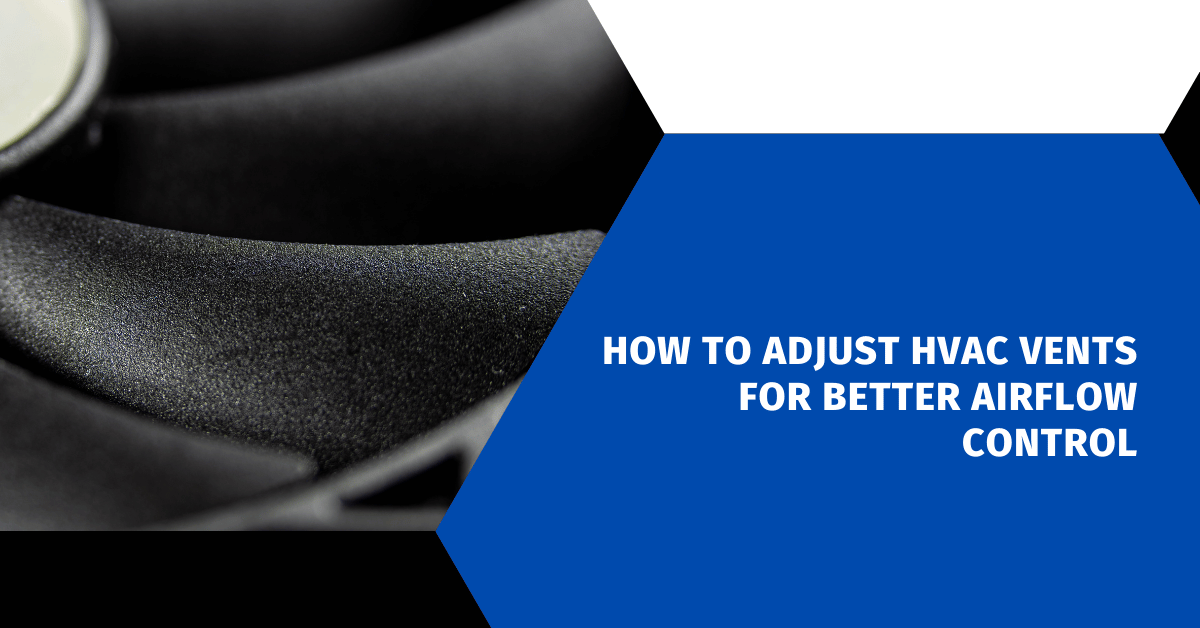Affiliate Disclosure
HVAC Guide Guys is a participant in the Amazon Services LLC Associates Program, an affiliate advertising program designed to provide a means for sites to earn advertising fees by advertising and linking to Amazon.
How to Adjust HVAC Vents for Better Airflow Control? Are you tired of dealing with uneven temperatures and high energy bills at home? Learning how to adjust your HVAC vents might be the answer you’ve been looking for. Making these adjustments can greatly enhance your home’s comfort and save on energy costs.

Many homeowners don’t know that tweaking their vents can change their home’s climate. With HVAC airflow issues potentially cutting system performance by up to 15%, it’s key to learn how to adjust vents. This ensures a cozy living space.
Your home’s heating and cooling system needs the right air flow. By mastering how to adjust vents, you can get rid of hot and cold spots. This also cuts down on energy waste and balances your home’s temperature.
Key Takeaways
- HVAC vent adjustment can improve home comfort
- Proper airflow reduces energy consumption
- Simple vent modifications can resolve temperature inconsistencies
- Regular vent maintenance prevents system inefficiencies
- Understanding airflow basics helps optimize home climate control
Table of Contents
Understanding HVAC Airflow Basics
Your home’s HVAC system is complex. It’s designed to move air well and keep your space comfortable. Knowing how air moves helps make your home better.
HVAC systems have important parts to move air right. They aim to spread air evenly in your rooms.
Core Components of Air Distribution
- Ductwork: The main way air moves
- Registers and vents: Where air goes
- Air handler: Moves air around
- Blower motor: Makes air flow
Understanding HVAC Vent Varieties
There are different vents for your home’s air system:
| Vent Type | Primary Function |
|---|---|
| Supply Vents | Bring in cool air |
| Return Vents | Take air back for reuse |
| Exhaust Vents | Take out old air and moisture |
Air Pressure Dynamics in Ventilation
Air pressure is key for good air flow. Positive pressure pushes air out. Negative pressure pulls air in. Knowing this helps move air better in your home.
“Proper air distribution is the key to maintaining comfort and energy efficiency in your living space.” – HVAC Engineering Experts
Understanding these basics helps you manage your home’s air. This makes your living space more comfortable.
Signs Your Home Has Airflow Problems
Spotting airflow issues in your home can prevent expensive HVAC repairs. It also boosts your system’s efficiency. Your heating and cooling system gives clear signs when something’s off.
Spotting blocked air vents and airflow problems needs careful observation. Look out for these warning signs:
- Inconsistent room temperatures
- Weak air circulation from vents
- Unusual noises from ductwork
- Unexpected increase in energy bills
Temperature differences between rooms can mean big ventilation problems. If some rooms are way warmer or cooler, it might mean airflow issues or blockages.
| Airflow Problem | Potential Cause | Recommended Action |
|---|---|---|
| Weak Air Output | Clogged Air Filters | Replace Filters Regularly |
| Uneven Room Temperatures | Blocked Vents | Clear Obstructions |
| Warm Air During Cooling | Refrigerant Issues | Professional Inspection |
If you notice warm air when it should be cool, or hear odd sounds, it’s a big sign. Your HVAC system needs a pro check-up right away to avoid more problems.
Explore Our HVAC Shop
Looking for top-rated HVAC tools, parts, and accessories? Visit our shop and find the perfect solution for your needs.
Visit the ShopHow to Adjust HVAC Vents for Optimal Performance
Balancing air vents is key to keeping your home comfortable. Learning how to adjust vents can make your HVAC system work better. This improves your comfort at home.
Step-by-Step Vent Adjustment Guide
Adjusting your HVAC vents needs a clear plan. Here are the main steps for balanced airflow:
- Find rooms with uneven temperatures
- Find all supply and return air vents
- Check the adjustable louvers’ direction
- Adjust vents slowly
- Watch room temperatures after each change
Tools Needed for Vent Adjustment
To adjust vents for better room temperature, you’ll need these tools:
- Ladder or step stool
- Screwdriver
- Thermometer
- Notebook for tracking changes
Common Adjustment Mistakes to Avoid
Homeowners often make mistakes when adjusting vents. These mistakes can harm your HVAC system:
- Shutting too many vents
- Ignoring return air vents
- Not keeping airflow consistent
- Missing obstructions
Pro tip: Small, gradual changes are best for even temperature.
Balancing Room Temperature Through Vent Control

Creating a cozy home environment starts with smart hvac vent adjustments. Each room has its own temperature needs, based on size, sun exposure, and how often it’s used. Learning to control airflow is key to keeping your home comfortable everywhere.
Room size is a big factor in temperature balance. Big rooms need more air flow than small ones. When adjusting hvac vents, remember these important points:
- Room dimensions and ceiling height
- Window placement and sun exposure
- Furniture arrangement
- Daily room usage patterns
Closing hvac registers in unused rooms can help direct air to where it’s needed more. This makes your heating and cooling system work better.
“Balanced airflow is the secret to maintaining consistent home comfort” – HVAC Experts
Here’s a quick guide to help you understand airflow:
| Room Type | Recommended Airflow | Vent Adjustment Strategy |
|---|---|---|
| Large Living Areas | High Volume | Open vents wider, ensure multiple registers |
| Bedrooms | Moderate Volume | Partial vent opening, balanced distribution |
| Home Office | Low to Moderate | Adjust based on electronic equipment heat |
Try out different hvac vent adjustments to find what works best for your home’s layout and comfort.
Seasonal Strategies for Vent Adjustment
Your HVAC system needs different strategies for each season. Knowing how to adjust vents can make your home more comfortable and save energy.
Seasons change how your home feels and breathes. Adjusting vents right helps keep your home comfy and cuts down on energy use.
Summer Airflow Optimization
In summer, focus on cooling your home efficiently:
- Open vents fully in living areas
- Partially close vents in unused rooms
- Direct cool air towards ceiling to maximize airflow circulation
“Effective vent positioning can reduce cooling costs by up to 20%” – HVAC Efficiency Institute
Winter Ventilation Techniques
Winter needs a different strategy for airflow and warmth:
- Adjust vents to direct warm air towards floor level
- Slightly close vents in unused rooms to concentrate heat
- Ensure vents near windows are fully open to prevent cold spots
Transitional Season Adjustments
Spring and fall need flexible vent management. Balanced airflow is key during these times when temperatures change a lot.
Your aim is to keep room temperatures steady while adjusting to outside changes. Regularly adjusting vents helps your HVAC system work better and last longer.
Explore Our HVAC Shop
Looking for top-rated HVAC tools, parts, and accessories? Visit our shop and find the perfect solution for your needs.
Visit the ShopMaximizing HVAC Efficiency with Proper Vent Positioning
Proper vent positioning is key to your home’s comfort and energy use. By redirecting air flow, you can boost HVAC efficiency and cut down on energy bills. Your home’s layout and where you place furniture greatly affect air flow.
To get the most out of your HVAC system, try these tips:
- Clear obstructions from vents to ensure unimpeded airflow
- Use vent deflectors to guide air around furniture and rooms
- Adjust vent louvers to control direction and intensity of air distribution
Where you put your furniture matters a lot for air flow. Keep sofas, bookcases, and large objects at least 6 inches away from vents. This simple move helps air flow better and saves your HVAC system from extra work.
Proper vent positioning can reduce energy costs by up to 15% annually.
Think about getting adjustable vent covers for better airflow control. These tools let you target specific areas in your home. They help make your HVAC system more efficient by avoiding cold or hot spots.
Every room might need a different vent setup. Take time to try out different arrangements. This will help you find the best balance of comfort and energy savings for your space.
Troubleshooting Common Vent-Related Issues
HVAC systems face many challenges that affect your home’s comfort and air quality. It’s important to know how to spot and fix blocked air vents and uneven airflow. This helps keep your heating and cooling system running well.
Many homeowners run into common vent problems that mess with their room’s temperature. Spotting these issues early can stop bigger HVAC problems.
Identifying Blocked Vents
Blocked air vents can really cut down your HVAC system’s performance. Watch out for these signs:
- Reduced airflow from specific registers
- Unusual whistling or hissing sounds
- Visible dust or debris around vent openings
- Uneven room temperatures
Dealing with Leaky Ducts
Leaky ducts waste energy and lower your system’s efficiency. Check your ductwork for:
- Visible gaps or disconnections
- Tape or sealant deterioration
- Unusual noises when the system runs
- Increased energy bills
Resolving Uneven Airflow
To fix uneven airflow and improve room temperature, try these steps:
- Clear obstructions near vents
- Clean or replace air filters regularly
- Adjust vent louvers to direct airflow
- Check for furniture blocking air circulation
Pro tip: If DIY fixes don’t work, get a professional HVAC technician for a full system check.
Explore Our HVAC Shop
Looking for top-rated HVAC tools, parts, and accessories? Visit our shop and find the perfect solution for your needs.
Visit the ShopMaintenance Tips for Optimal Vent Performance

Keeping your HVAC vents in top shape is key for better hvac efficiency. It ensures good airflow in your home. Regular upkeep stops problems and keeps your system running well.
To keep your hvac vents working right, follow these important steps:
- Clean vent covers monthly to get rid of dust and debris that can block air
- Change air filters every 90 days, or more often if you have pets or lots of dust
- Vacuum around register openings and nearby to stop dust buildup
- Look for any blockages near vent openings
“Preventative maintenance is the key to a long-lasting and efficient HVAC system.” – HVAC Professional
Seasonal checks are vital for your home’s ventilation system. During these, look for wear signs, listen for odd sounds, and make sure vents work right.
Experts say to make a maintenance plan that includes:
- Bi-annual professional system checks
- Regular filter changes
- Deep cleaning of vents and ducts every 3-5 years
By spending time on proper vent care, you can greatly boost hvac efficiency. This also cuts down energy costs and makes your heating and cooling system last longer.
Professional vs DIY Vent Adjustment
Adjusting hvac vents can be tricky. Some homeowners are okay with small changes, but others might struggle. It’s important to know when to adjust vents yourself and when to call a pro.
Here are some scenarios for DIY vs professional vent adjustment:
- Simple register adjustments in accessible rooms
- Cleaning visible vent covers
- Basic airflow redirections
But, you might need a pro for more complex issues:
- Extensive ductwork modifications
- Persistent uneven temperature distribution
- Advanced system diagnostics
| DIY Vent Adjustment | Professional Intervention |
|---|---|
| Low complexity | High technical expertise required |
| Minimal tools needed | Specialized equipment |
| Quick fixes | Comprehensive system assessment |
It’s key to know your limits to avoid damaging your HVAC. When unsure, get advice from a certified HVAC technician. They can help with balancing air vents and keeping your system running well.
Conclusion
Learning how to adjust HVAC vents is key to a cozy home. This guide shows you how to boost airflow and even out temperatures. It’s not just about setting the right temperature; it’s about making your heating and cooling work better.
Success in vent management comes from watching and adjusting carefully. Check your vents often, keep them clean, and tweak settings for each room. Adjusting vents is a continuous effort to keep your home comfy.
Energy use and comfort are linked with HVAC systems. Knowing how air flows in your home can save energy and make it more comfortable. Whether it’s summer or winter, smart vent placement can greatly improve your home’s climate.
While these tips are helpful, sometimes you need a pro. If you face ongoing airflow problems or system issues, get expert help.

